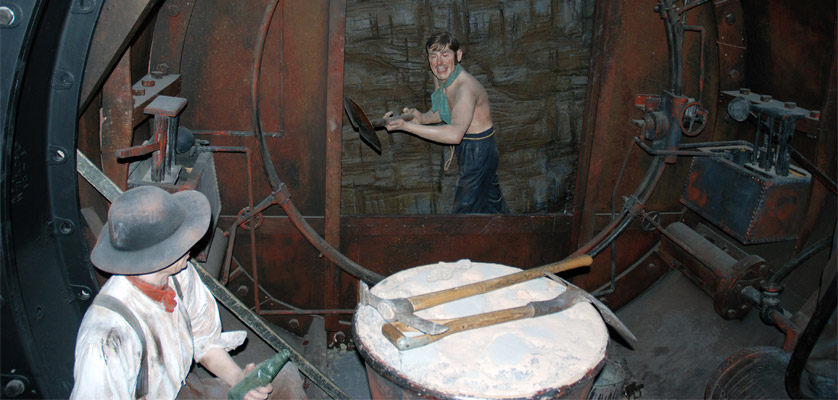London Underground: The Build
The creation of the London Underground began in the mid-19th century, after solicitor Charles Pearson announced his idea to improve the capital's transport system in 1845.
He wanted to help commuters in the suburbs to reach their workplace, but his seemingly futuristic plans for an underground transport network weren't well received at first.
The London-born solicitor suggested a central rail station that would be accessed by a tunnel and used by several different rail operators. His proposals were turned down as unworkable, but he used his influence as a solicitor to lobby the authorities for the next nine years.
Finally, the Royal Commission agreed to look into his ideas for a new underground railway system and a Private Bill for the Metropolitan Railway was passed on 7th August 1854.

Design
Civil engineer John Fowler, who had also built the Forth Railway Bridge, designed the first stages of the London Underground system. Construction began between Farringdon and Praed Street in Paddington.
Architect Harry Bell Measures designed Oxford Circus Station and fellow architect John Wolfe-Barry, the designer of Tower Bridge, created most of the District Line.
Additional surface railway lines and stations were also built, including the London and South Western Railway's line to Waterloo Bridge from Southampton and Richmond.
The £229,064 main tunnelling contract (the equivalent of around £23.9 million today) was awarded to John Mowlem and Co. Work began when platforms known as "staging" were constructed in the Thames, about 500ft west of Blackfriars Bridge.
Construction
A watertight enclosure, known as a cofferdam, enabled construction to begin below the waterline. Two vertical shafts, with an internal diameter of 16ft each, were built to a depth of 45ft. Tunnelling was carried out by an army of labourers working underground in cramped, hot conditions.
The work was physically demanding, with the labourers using the Greathead system of shield excavation. Each shaft accommodated 20 men, who completed cast iron segment lining and compressed air grouting.
A narrow gauge railway conveyed the excavated materials to the staging near Blackfriars Bridge for removal. The first Underground lines, completed in the late 1860s and 1870s, connected some of the suburbs to the city centre.
The underground tunnel-boring method had been developed to minimise the risk of the tunnel collapsing. It used a frame to shield the workers as they tunnelled in individual compartments. JH Greathead's hydraulically-operated tunnel shield was efficient and also saved lives.
Armstrong Lift
A variety of hydraulic rams were used, the main one being the Armstrong lift. It used to be powered by water, but then changed to hydraulics, which were more effective.
It was crucial to the construction of the Underground, because the passenger cars had to be taken to the line, as there was no ground-level section. The carriages also had to be taken out for maintenance.
The Armstrong Lift was located to the west of the Windsor side of Waterloo main line station. It was manufactured by Sir WG Armstrong Whitworth & Co Ltd. The company was paid £3,560 for the equipment.
At this time, hydraulic power was often used in urban areas to operate lifts and hoists and was supplied by the utility companies. The Underground lift had to be strong enough to lift 27 tons.
Construction of the lift was completed in April 1898. In addition, a smaller 23-ton hoist was constructed at Waterloo in the low-level siding area. This was installed for £595 by John Abbot & Co and would move the boiler fuel wagons. It had a smaller travel area, hence it was cheaper.
20th century
The London Underground continued to expand throughout the 20th century. British Transport Films made a short documentary about the construction of the Victoria Line in 1965. People above ground were enjoying the sunshine, having no idea of the activity going on below.
<iframe width="100%" height="50%" src="https://www.youtube.com/embed/-zhg0mPk4FM" frameborder="0" allow="accelerometer; autoplay; encrypted-media; gyroscope; picture-in-picture" allowfullscreen></iframe>
The workers dug out 23 miles of tunnel to complete the Victoria Line, adding huge segments of metal to make the tunnel's sides. Miners carrying out the exhausting work were described as "human moles", as they finished off the 21ft-diameter tunnel with the segments of roof. Work continued 24 hours a day to ensure it was completed on time.
Even in the modern era, road vehicles are required for rolling stock exchanges. Before the construction of Waterloo International terminal in the 1990s, the Armstrong Lift was still used to hoist the vehicles individually outside the Waterloo main line station.
Today, this procedure is completed by a road-mounted crane in a shaft next to the depot, on Spur Road. It is used only for major maintenance work to lift the car body. Routine maintenance work is carried out at the Waterloo depot.
The remains of the siding tunnel that used to lead to the Armstrong Lift is visible on the left-hand side of the train, as it leaves Waterloo for Bank. However, the lift itself was sadly buried with the complete Western sidings in 1992, when the Waterloo International station (the Eurostar trains' terminal) was constructed.
Elizabeth Line
Today, the London Underground transports five million passengers a day along its 402km of tracks, which connect 270 stations, linked by 11 lines. The network transports 1.265 billion passengers around 76.4 million kilometres every year and is one of the busiest rail networks in the world.
Expansion of the Underground continues today, with the latest addition being the new Elizabeth Line. It will span more than 60 miles from Heathrow and Reading in the west, through central tunnels across to Abbey Wood and Shenfield in the east.
Constructed by Crossrail Ltd, it will stop at 41 stations, 10 of which are being newly built, with the remainder being upgraded. It will transport around 200 million people annually.
In August 2018, Crossrail Ltd asked for more time to complete the section through central London. The government agreed new financing on 10th December 2018 and the new opening date is yet to be announced. The original launch date for the central section was autumn 2019.
The £14.8 billion Elizabeth Line is the biggest construction project in Europe and since the construction began in 2009, more than 15,000 people have worked on the project, clocking up more than 120 million working hours.
A dedicated team of engineers has been working 24 hours a day to install power, signalling, tunnel ventilation, communications and overhead line equipment.
Established for more than 35 years, Phoenix Hydraulics is one of the UK's largest independent hydraulics companies. We provide hydraulic engineering solutions in many industry sectors.
Give us a call on 01733 234800 for further information.


